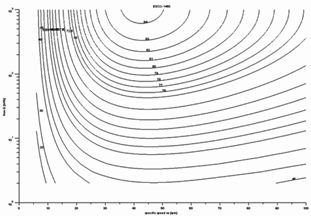ANNEX IIU.K. Ecodesign requirements for water pumps
1.EFFICIENCY REQUIREMENTSU.K.
(a)From 1 January 2013, water pumps shall have a minimum efficiency:U.K.
at the best efficiency point (BEP) of at least (ηΒΕΡ) min requ, when measured according to Annex III, and calculated with the C-value for MEI = 0,1, according to Annex III,
a minimum efficiency at part load (PL) of at least (ηΡL) min requ when measured according to Annex III, and calculated with the C-value for MEI = 0,1, according to Annex III,
a minimum efficiency at over load (OL) of at least (ηΟL) min requ when measured according to Annex III and calculated with the C-value for MEI = 0,1, according to Annex III.
(b)From 1 January 2015, water pumps shall have:U.K.
a minimum efficiency at the best efficiency point (BEP) of at least (ηΒΕΡ) min requ when measured according to Annex III and calculated with the C-value for MEI = 0,4, according to Annex III,
a minimum efficiency at part load (PL) of at least (ηΡL) min requ when measured according to Annex III and calculated with the C-value for MEI = 0,4, according to Annex III,
a minimum efficiency at over load (OL) of at least (ηΟL) min requ when measured according to Annex III and calculated with the C-value for MEI = 0,4, according to Annex III.
2.PRODUCT INFORMATION REQUIREMENTSU.K.
From 1 January 2013, the information on water pumps referred to in Article 1 set out in following points (1) to (15) shall be visibly displayed on:
the technical documentation of water pumps;
free access websites of manufacturers of water pumps.
The information shall be provided in the order as presented in points (1) to (15). The information referred to in points (1) and (3) to (6) shall be durably marked on or near the rating plate of the water pump.
(1)Minimum efficiency index: MEI ≥ [x,xx];U.K.
(2)Standard text: ‘The benchmark for most efficient water pumps is MEI ≥ 0,70’, or, alternatively, the indication ‘Benchmark MEI ≥ 0,70’;U.K.
(3)Year of manufacture;U.K.
(4)Manufacturer’s name or trade mark, commercial registration number and place of manufacture;U.K.
(5)Product’s type and size identificator;U.K.
(6)Hydraulic pump efficiency (%) with trimmed impeller [xx,x], or, alternatively, the indication [–.-];U.K.
(7)Pump performance curves for the pump, including efficiency characteristics;U.K.
(8)Standard text: ‘The efficiency of a pump with a trimmed impeller is usually lower than that of a pump with the full impeller diameter. The trimming of the impeller will adapt the pump to a fixed duty point, leading to reduced energy consumption. The minimum efficiency index (MEI) is based on the full impeller diameter.’;U.K.
(9)Standard text: ‘The operation of this water pump with variable duty points may be more efficient and economic when controlled, for example, by the use of a variable speed drive that matches the pump duty to the system’;U.K.
(10)Information relevant for disassembly, recycling or disposal at end-of-life;U.K.
(11)Standard text for water pumps designed only for pumping clean water at temperatures below – 10 °C: ‘Designed for use below – 10 °C only’;U.K.
(12)Standard text for water pumps designed only for pumping clean water at temperatures above 120 °C: ‘Designed for use above 120 °C only’;U.K.
(13)For pumps designed specifically for pumping clean water at temperatures below – 10 °C or above 120 °C, manufacturer must describe the relevant technical parameters and characteristics used;U.K.
(14)Standard text: ‘information on benchmark efficiency is available at [www.xxxxxxxxx.xxx]’;U.K.
(15)Benchmark efficiency graph for MEI = 0,7 for the pump based on the model shown in the Figure. Similar efficiency graph shall be provided for MEI = 0,4.U.K.
Figure Example of a benchmark efficiency graph for ESOB 2900U.K.
Further information may be added and may be complemented by graphs, figures or symbols.
